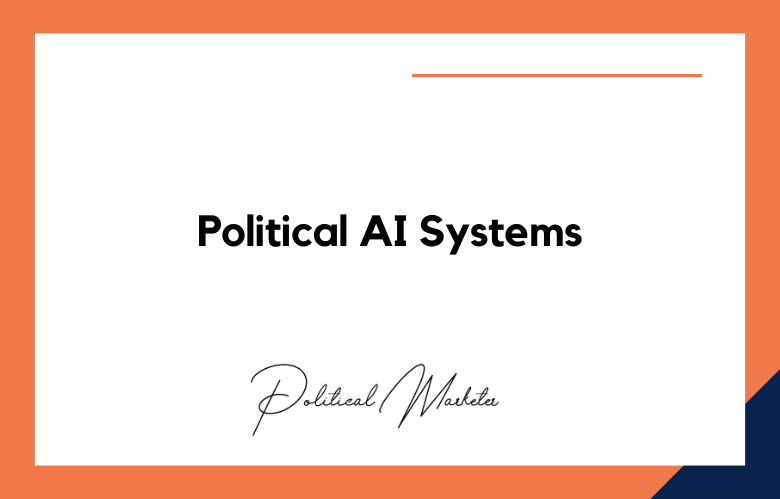Advancements in technology are dramatically altering the world of politics. One technology that is gaining increasing attention is AI-powered voter sentiment analysis.
With the ability to analyze vast amounts of data in real-time, political campaigns can now better understand voter preferences and opinions.
This technology allows campaigns to revise messaging, target specific groups, and win elections. I will explore how AI-powered voter sentiment analysis is revolutionizing political campaigns.
What is AI-powered Voter Sentiment Analysis?
AI-powered voter sentiment analysis uses AI algorithms to analyze public sentiments, opinions, emotions, and attitudes to political events, topics, and candidates.
These algorithms use natural language processing and machine learning techniques to understand the meaning and context of people’s expressions and to draw conclusions from large datasets.
The Importance of AI-Powered Voter Sentiment Analysis
Every political party and campaign aspires to win voters’ hearts and minds. However, this goal is not achievable without diverse and complex opinions and perspectives. AI sentiment analysis enables movements to understand diverse viewpoints and opinions independently of whether or not voters voice them.
This provides the opportunity to engage voters, address their concerns, and tailor the party’s message for the target voter group. Therefore, AI-powered voter Sentiment Analysis can provide a strategic advantage to political campaigns that use it.
Real-life Examples of AI-Powered Voter Sentiment Analysis
Facebook Political Ads
Facebook has been using AI-powered voter sentiment analysis to help political campaigns better target their ads.
By analyzing user data, the company can determine which users are more likely to respond positively to specific political messages and target them with tailored ads. This helps campaigns better understand their audience and craft messages that resonate with them.
Twitter Sentiment Analysis
Twitter is another platform that uses AI-powered sentiment analysis to track users’ feelings about specific topics or candidates.
The platform analyzes tweets in real-time and assigns each one a sentiment score based on the language used in the tweet. This allows campaigns to gauge how the public reacts to their message and adjust accordingly.
Polling
AI-powered voter sentiment analysis can also be used for polling purposes. By analyzing large amounts of data from surveys, polls, and other sources, AI algorithms can accurately predict election outcomes by determining which candidate is more prevalent among voters.
This helps campaigns get an accurate picture of where they stand regarding public opinion before election day arrives.
Automated Messaging
AI-powered voter sentiment analysis can also be used for automated messaging purposes. By analyzing user data, campaigns can create computerized messages tailored specifically for each user based on their interests and preferences.
This helps ensure that each message resonates with its intended recipient and increases the likelihood of conversion or engagement with the campaign’s message.
Targeted Advertising
AI-powered voter sentiment analysis can also be used for targeted advertising purposes.
By analyzing user data, campaigns can identify which users are more likely to respond positively to certain ads and target them with tailored advertisements that will resonate with them more effectively than generic ads would do otherwise.
This helps increase the effectiveness of a campaign’s advertising efforts while saving time and money.
Social Media Monitoring
AI-powered voter sentiment analysis can also be used to monitor social media. By tracking conversations on social media platforms such as Twitter and Facebook, campaigns can understand how people feel about specific issues or candidates without conducting costly research studies or polls beforehand.
Limitations of AI-Powered Voter Sentiment Analysis
Limited Understanding of Human Language
One of the primary limitations of AI-powered voter sentiment analysis is its limited understanding of human language. AI-powered tools are designed to detect patterns in data, but they need help interpreting the nuances and subtleties of human language.
This can lead to inaccurate results as AI-powered tools may not accurately interpret the true meaning behind a statement or phrase.
Difficulty Interpreting Nonverbal Cues
Another limitation of AI-powered voter sentiment analysis is its difficulty interpreting nonverbal cues.
Nonverbal cues, such as facial expressions and body language, can provide valuable insight into a person’s feelings and beliefs. However, AI-powered tools still need to be advanced enough to interpret these subtle cues accurately, which can lead to inaccurate results.
Lack of Context
AI-powered voter sentiment analysis also needs more context when interpreting data. For example, an AI tool may detect a pattern in a particular set of data points, but it may not understand the broader context in which those data points exist.
This lack of context can lead to inaccurate conclusions about voter sentiment that do not consider other factors that could affect the outcome of an election.
Limited Ability to Detect Changes Over Time
AI-powered voter sentiment analysis also cannot detect changes in voter sentiment over time.
For an AI tool to accurately measure changes in voter sentiment over time, it must be trained on large amounts of historical data from previous elections or polls that span several years or even decades. With this historical data, an AI tool may accurately measure changes in voter sentiment over time.
Potential for Biased Results
Another limitation of AI-powered voter sentiment analysis is its potential for biased results due to algorithmic bias or incorrect assumptions made by algorithm designers about how people think and behave politically.
Algorithmic bias occurs when an algorithm produces results that favor one group over another based on incorrect assumptions about their political beliefs or behavior patterns. This can lead to inaccurate conclusions about voter sentiment and potentially inappropriate influence on election outcomes.
High Cost
Using AI-powered tools for voter sentiment analysis can be expensive due to the cost of developing and maintaining these complex algorithms and systems and purchasing large amounts of historical data needed for training.
Benefits of AI-Powered Voter Sentiment Analysis
The benefits of AI-powered voter sentiment analysis for political campaigns are vast. Campaigns can quickly identify issues that voters in certain areas care about, track the effectiveness of their messaging, and understand how they are perceived. Sentiment analysis also helps politicians know what to say or avoid saying.
Real-time analysis
Before the emergence of voter sentiment analysis, political campaigns had to rely on traditional polling methods to gauge voter opinion. These polls could take days or weeks to complete, leaving movements with outdated information when it was analyzed.
With AI-powered voter sentiment analysis, data can be interpreted in real-time. Social media feeds, news outlets, and other online sources can be monitored continuously, allowing campaigns to stay current and adapt their strategy accordingly.
Targeted messaging
Most political campaigns have a core set of beliefs and ideas that they want to communicate to voters. However, how these messages are presented can vary depending on the audience.
With AI-powered voter sentiment analysis, campaigns can identify which messages are resonating with specific groups of voters and adjust their messaging accordingly.
For example, a campaign may learn that environmental issues are important to millennial voters in a particular region. They could then tailor their messaging to highlight their environmental policies in that area.
Predictive modeling
AI-powered voter sentiment analysis can also be used for predictive modeling. By analyzing historical data, campaigns can identify critical factors influencing voter sentiment.
This can include economic indicators, social issues, and demographic data. With this information, campaigns can make more informed decisions about where to allocate resources, which ads to run, and which states or regions to focus on.
Improved turnout
One of the main goals of any political campaign is to get as many people to vote as possible. AI-powered voter sentiment analysis can help identify voter groups that may be less likely to vote. With this information, campaigns can create targeted outreach campaigns to encourage these groups to vote.
For example, a campaign may learn that young people in a particular area are less likely to turn out to vote. To encourage these voters to go to the polls, a targeted ad campaign using social media could be created.
Improved analytics
AI-powered voter sentiment analysis can help campaigns improve their analytics. By removing biases and inaccuracies, campaigns can rely on more accurate data to make decisions.
This can help them identify which strategies are working and which ones are not. Over time, campaigns can use this information to refine their tactics and improve performance.
Conclusion:
AI-powered voter sentiment analysis is revolutionizing political campaigns. With real-time analysis, targeted messaging, predictive modeling, improved turnout, and better analytics, movements can make more informed decisions and win elections.
As technology advances, we can expect even more changes in how political campaigns are run. It’s an exciting time to be involved in politics, and AI-powered voter sentiment analysis is one reason why.
AI-Powered Voter Sentiment Analysis for Political Campaigns: FAQs
What Is AI-Powered Voter Sentiment Analysis?
AI-powered voter sentiment analysis uses artificial intelligence algorithms to evaluate public opinion by analyzing text, speech, and behavior data from social media, news, forums, and surveys.
Why Is Sentiment Analysis Important In Political Campaigns?
It provides real-time insights into voters’ feelings about issues, candidates, and events, helping political teams make informed strategic decisions.
How Does AI Detect Voter Sentiment?
AI uses natural language processing (NLP), machine learning, and emotion detection models to classify opinions as positive, negative, or neutral across various platforms.
Which Data Sources Are Commonly Used For Sentiment Analysis?
Social media posts, online news comments, public forums, email feedback, campaign surveys, and call center transcripts are frequently analyzed.
Can AI Monitor Sentiment Across Different Languages And Regions?
Yes. Advanced AI tools are trained to understand regional dialects and multiple languages, enabling campaigns to localize sentiment insights.
How Frequently Should Campaigns Track Voter Sentiment?
Daily or weekly monitoring is recommended during campaign seasons to catch shifts in public mood and respond proactively.
What Are The Benefits Of Using AI Over Traditional Polling Methods?
AI offers real-time, large-scale, and low-cost sentiment analysis, unlike traditional polling, which is slower, expensive, and limited in scope.
Can AI Sentiment Analysis Predict Election Outcomes?
While not infallible, AI models can accurately detect trends and voter leaning when combined with historical data and polling.
How Can Sentiment Data Influence Campaign Messaging?
It helps refine narratives, identify resonating topics, detect backlash, and personalize communication for targeted voter groups.
Is Sentiment Analysis Useful For Crisis Management?
Absolutely. It can quickly detect rising negativity or controversy, allowing campaigns to address issues before they spiral out of control.
Can AI Distinguish Between Sarcasm And Genuine Opinion?
Advanced models can identify sarcasm, irony, and contextual cues, although accuracy may vary depending on the platform and language.
How Does Sentiment Analysis Integrate With Social Listening?
Sentiment analysis is a core function of social listening platforms, which track keywords, mentions, and brand perception across digital ecosystems.
What Tools Are Used For Political Sentiment Analysis?
Tools include Brandwatch, Hootsuite Insights, Talkwalker, NetBase Quid, Google NLP API, and custom-built AI dashboards.
Can Sentiment Analysis Identify Regional Variations In Voter Opinion?
Yes. By tagging data with geographic metadata, campaigns can identify sentiment clusters and prioritize high-impact locations.
Is AI-Based Sentiment Analysis Ethical In Political Campaigning?
It is ethical if used to understand public opinion rather than manipulate it, and when compliant with data privacy laws and consent guidelines.
How Accurate Is AI-Powered Sentiment Analysis?
Accuracy ranges from 70% to 90%, depending on model training, data quality, and platform context. Human validation still enhances reliability.
Can Sentiment Analysis Help In Voter Segmentation?
Yes. Voters can be grouped based on emotional response to issues or candidates, aiding in personalized outreach and micro-targeting.
Does Sentiment Analysis Work On Audio And Video Data?
Yes. AI can transcribe and analyze tone, speech patterns, and word choices from video interviews, debates, or voter testimonials.
How Can Campaigns Act On Negative Sentiment Quickly?
By issuing clarifications, adjusting messaging, engaging directly with critics, or deploying influencers to reshape the narrative.
What Is The Future Of AI In Political Sentiment Analysis?
The future includes real-time dashboards, predictive sentiment modeling, multilingual emotion recognition, and deeper integration with campaign decision-making tools.










